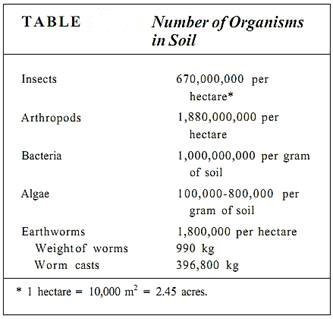

النبات

مواضيع عامة في علم النبات

الجذور - السيقان - الأوراق

النباتات الوعائية واللاوعائية

البذور (مغطاة البذور - عاريات البذور)

الطحالب

النباتات الطبية


الحيوان

مواضيع عامة في علم الحيوان

علم التشريح

التنوع الإحيائي

البايلوجيا الخلوية


الأحياء المجهرية

البكتيريا

الفطريات

الطفيليات

الفايروسات


علم الأمراض

الاورام

الامراض الوراثية

الامراض المناعية

الامراض المدارية

اضطرابات الدورة الدموية

مواضيع عامة في علم الامراض

الحشرات


التقانة الإحيائية

مواضيع عامة في التقانة الإحيائية


التقنية الحيوية المكروبية

التقنية الحيوية والميكروبات

الفعاليات الحيوية

وراثة الاحياء المجهرية

تصنيف الاحياء المجهرية

الاحياء المجهرية في الطبيعة

أيض الاجهاد

التقنية الحيوية والبيئة

التقنية الحيوية والطب

التقنية الحيوية والزراعة

التقنية الحيوية والصناعة

التقنية الحيوية والطاقة

البحار والطحالب الصغيرة

عزل البروتين

هندسة الجينات


التقنية الحياتية النانوية

مفاهيم التقنية الحيوية النانوية

التراكيب النانوية والمجاهر المستخدمة في رؤيتها

تصنيع وتخليق المواد النانوية

تطبيقات التقنية النانوية والحيوية النانوية

الرقائق والمتحسسات الحيوية

المصفوفات المجهرية وحاسوب الدنا

اللقاحات

البيئة والتلوث


علم الأجنة

اعضاء التكاثر وتشكل الاعراس

الاخصاب

التشطر

العصيبة وتشكل الجسيدات

تشكل اللواحق الجنينية

تكون المعيدة وظهور الطبقات الجنينية

مقدمة لعلم الاجنة


الأحياء الجزيئي

مواضيع عامة في الاحياء الجزيئي


علم وظائف الأعضاء


الغدد

مواضيع عامة في الغدد

الغدد الصم و هرموناتها

الجسم تحت السريري

الغدة النخامية

الغدة الكظرية

الغدة التناسلية

الغدة الدرقية والجار الدرقية

الغدة البنكرياسية

الغدة الصنوبرية

مواضيع عامة في علم وظائف الاعضاء

الخلية الحيوانية

الجهاز العصبي

أعضاء الحس

الجهاز العضلي

السوائل الجسمية

الجهاز الدوري والليمف

الجهاز التنفسي

الجهاز الهضمي

الجهاز البولي


المضادات الميكروبية

مواضيع عامة في المضادات الميكروبية

مضادات البكتيريا

مضادات الفطريات

مضادات الطفيليات

مضادات الفايروسات

علم الخلية

الوراثة

الأحياء العامة

المناعة

التحليلات المرضية

الكيمياء الحيوية

مواضيع متنوعة أخرى

الانزيمات
Introduction to Soils and Mineral Nutrition
المؤلف:
AN INTRODUCTION TO PLANT BIOLOGY-1998
المصدر:
JAMES D. MAUSETH
الجزء والصفحة:
31-10-2016
2020
Introduction to Soils and Mineral Nutrition
In addition to the carbon, hydrogen, and oxygen discussed with regard to photosynthesis and respiration, all organisms need elements such as nitrogen, phosphorus, calcium, magnesium, and sulfur. Plants must absorb these from soil and then use them and the glyceral-dehyde-3-phosphate from chloroplasts to build all their chemical components, however complex. This is an important concept: Plant metabolism is based on sunlight and chemical present in water, air, and soil. No animal is able to survive on just minerals and one simple carbohydrate; they must obtain minerals and complex organic compounds in their food Most of the elements that are essential for plant growth and development are present in the crystal matrix of minerals. The elements become available to roots as rocks weather and break down, creating soil. During soil formation, rocks are converted gradually into dis-solved ions and inorganic compounds. Because they are derived from the rock minerals, their role in plant nutrition is called mineral nutrition.
The term "mineral nutrition" covers a variety of types of plant metabolism. For some elements, once the mineral is absorbed from the soil, it can be used immediately as it is. An example is potassium, which is used by cells such as guard cells to adjust their turgor and water relations. Simple potassium ions are sufficient. Mineral elements such as iron and magnesium are more complex because they must be incorporated into compounds such as cytochromes or chlorophyll molecules before they are useful. Nitrogen is even more complicated: Like carbon, its oxidation state is important. Consequently, it must be reduced, and elaborate electron transport chains are necessary to convert it to useful forms.
The term "soil" covers a wide variety of substances. The various soils are important to plants not only in supplying minerals and harboring nitrogen-fixing bacteria, but also in holding water, supplying air to roots, and acting as a matrix that stabilizes plants, preventing them from blowing over. Critical aspects of soil are its chemical nature, which determines which mineral elements are present; its physical nature, which reflects is porosity, texture, and density; and its microflora and microfauna—the small animals, fungi, protists, and bacteria that live, respire, and gather food within the soil.
The microflora and microfauna of the soil deserve special mention. It is easy to think of soil in terms of its chemical and physical properties only, but that would be an incomplete concept of soil. Most soils contain large amounts of microbes and tiny animals that are extremely important to plants (Table ). Although they are microscopic to us, they are about the same size as roots and root hairs, and they interact extensively with root systems. For example, many soil microbes supply plants with nitrogen: Nitrogen is not found in rock matrixes, so soil formation does not make nitrogen available to plants. Instead, the primary source of nitrogen is the molecular nitrogen (N2) of the atmosphere, but only certain bacteria and cyanobacteria have enzymes that convert molecular nitrogen into forms useful for metabolism. When these microbes die and decay, their organic nitrogen compounds are released to the soil and become available to plants.
Just as the foods of animals vary, soils also vary in the quantities of minerals present, the texture of the soil, and the organisms present. Also, plants vary with regard to the amounts of minerals they require and their capacity for absorbing and processing minerals. All these factors affect a plant's health and, to a large extent, determine the types of plans that exist in a particular area.

 الاكثر قراءة في مواضيع عامة في علم النبات
الاكثر قراءة في مواضيع عامة في علم النبات
 اخر الاخبار
اخر الاخبار
اخبار العتبة العباسية المقدسة

الآخبار الصحية















 قسم الشؤون الفكرية يصدر كتاباً يوثق تاريخ السدانة في العتبة العباسية المقدسة
قسم الشؤون الفكرية يصدر كتاباً يوثق تاريخ السدانة في العتبة العباسية المقدسة "المهمة".. إصدار قصصي يوثّق القصص الفائزة في مسابقة فتوى الدفاع المقدسة للقصة القصيرة
"المهمة".. إصدار قصصي يوثّق القصص الفائزة في مسابقة فتوى الدفاع المقدسة للقصة القصيرة (نوافذ).. إصدار أدبي يوثق القصص الفائزة في مسابقة الإمام العسكري (عليه السلام)
(نوافذ).. إصدار أدبي يوثق القصص الفائزة في مسابقة الإمام العسكري (عليه السلام)


















